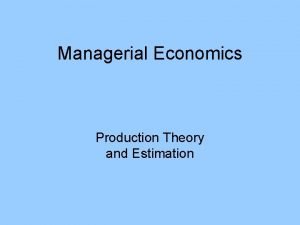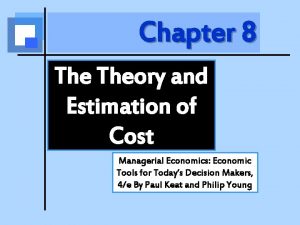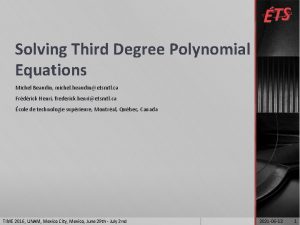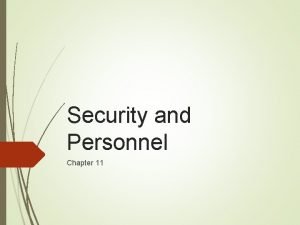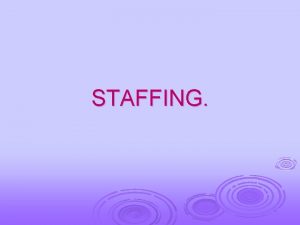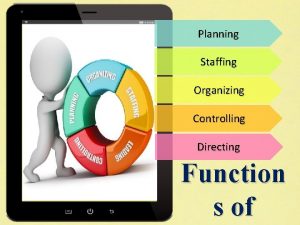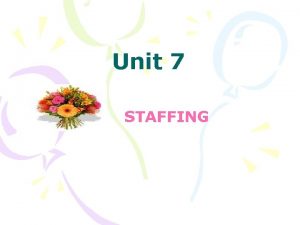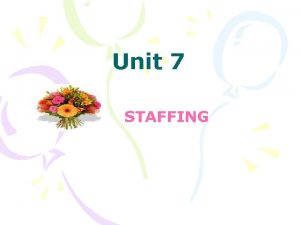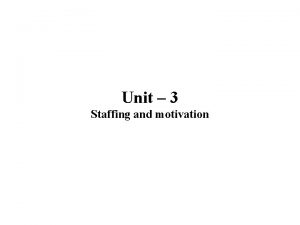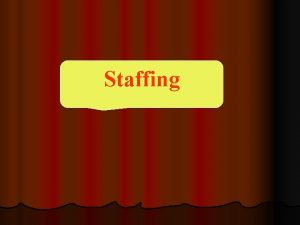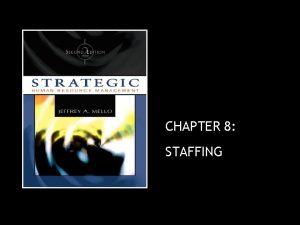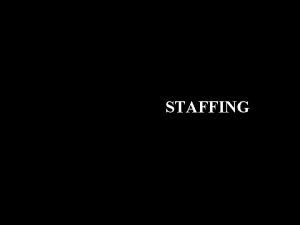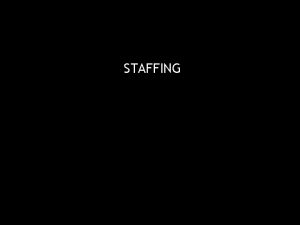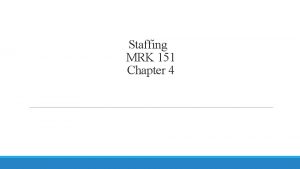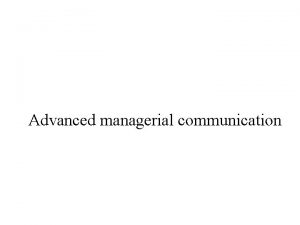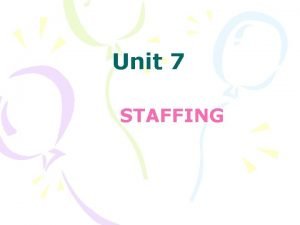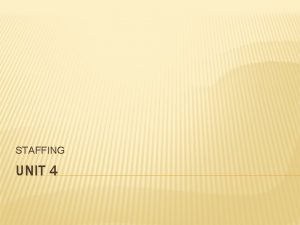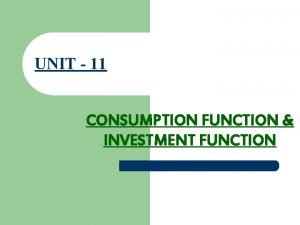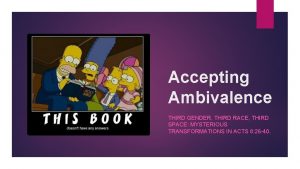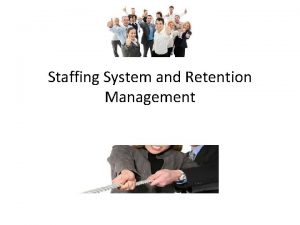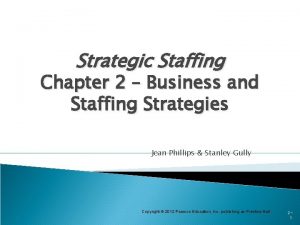Unit 7 STAFFING Staffing The third managerial function





















- Slides: 21

Unit 7 STAFFING

Staffing �The third managerial function: - Staffing involves selection of personnel and assignment systems and the determination of staffing schedules. - Adequacy of skilled staff to accomplish organizational goals is an important management function - Staffing: concerned with placing right persons in right positions. 2

�Practical application of designed organizational structure. �Separate and fundamental function of management. Definition: �Staffing: the process of assigning competent people to fill roles designed for organizational structure through (recruitment, selection, and development of personnel). 3

Purposes of staffing: 1. Assigning qualified people to appropriate jobs. 2. Assuring adequacy of skilled staff 3. Facilitates the achievement of organizational goals 4. Fulfill the need to supply enough staff according to standards and organizational structure 5. Increase job satisfaction 6. Decrease burn-out, turn-over and frustration of staff 7. Improving and maintaining the quality of care 8. Providing for cost-effectiveness of work. 4

Pre-employment staffing responsibilities: Selection of personnel : I. Recruitment and retention. II. Screening of staff. III. Pre-employment testing. IV. Physical Examination I. Recruitment and retention: seeking out or attracting applicants for existing position Recruitment strategies or methods: - Advertising. - Employee recommendation. (Word of mouth) - Recruitment literature: printed materials available to hand out or mail. � 5

2. Screening of staff: a. Application forms: quick way to collect demographic information, (personal history, education background, work experience, …etc. ) Supervisor should screen out applicants who don't fit agency's image. b. Letters of reference: Letters of recommendation may be requested from references. c. Interview ( selection interview ). Verbal interaction between individuals for a particular purpose. 6

�purposes of the interview: obtain information, and to determine if the applicant meets the requirements for the position. �The interview is universally accepted for selecting individuals for positions. Limitation of interview: Major defect of the interview is its subjectivity, - Supervisors use their own judgments, biases, and values to make decisions with short interaction with an applicant in an unnatural situation - 7

Overcoming interview limitations: 1 - Develop a structured interview format for each job classification: Each job has different position requirements, structured interview is more advantageous. 2 - Use scenarios to determine decision making ability: (to obtaining answers to a particular set of questions, same set of scenarios should be used with each category of employee). 8

3 - Conduct multiple interviews: - more than one interviewer for applicant reduces the bias. For most effective interview; applicant should be interviewed on two separate days. (This prevents applicants from being accepted or rejected because they were having a good or bad day). 4 - Use a team approach: use a hiring committee to interview job applicants. 5 - Give training in effective interview: Training about interview techniques & communication skills. 9

Planning, conducting & controlling the interview: Planning the interview is vital to success, interviewer should be available at the appointed time & give adequate time for the interview. - Before the interview, all interviewers should review the application, - Noting questions concerning information supplied by the applicant. - Using a planned sequence in the interview format make spontaneous and smooth process. � 10

III. Pre-employment testing. used as a selection tool. (Some organizations do post employment testing to determine learning needs or skill deficiencies). IV. Physical Examination : - After determining the most appropriate person to fit the job, manager must be sure that the same standards are used to evaluate all candidates - Final selection should be based on established & professional criteria. 11

Employee indoctrination: �Begins as soon as a person has been selected for a position, and continues until he has been socialized to the norms and values of the work group �Adjustment of an employee to both the organization and the work environment. 12

purposes of indoctrination: 1. Establish employee attitudes toward the organization, unit, and department. 2. Provide necessary education for success in the position 3. Enhance feeling of belonging and acceptance (increase employee satisfaction & higher productivity). 13

Phases of indoctrination process: A- Induction: ﺍﺳﺘﻘﺮﺍﺀ - After the employee has been selected and before beginning his job role. - Activities that educate new employee about the organizational policies and procedures. - Ex. employee handbooks, signed by employees, this signed form placed in the employee’s personnel file 14

�B- Orientation: -The manager introduces the nurse to her/his new job, agency policies, facilities, and coworkers - may be critical to his future job satisfaction and performance - Includes a tour of the hospital, depts. , fire safety, accident prevention, and health promotion - Manager may develop orientation schedule �C- Socialization: - Leader introduces employees to unit values, attitudes and culture 15

Clarifying role expectations: � 1 - Role models: - (someone you admire or want to emulate) : - Role models are experienced, competent employees. - The relationship bw the new employee and the role model is a passive one. - Increase number of excellent role models increase possibilities for new employees to perform well. 16

2 - Preceptors: �Experienced nurse who provides emotional support and is a strong clinical role model for the new nurse, �Preceptor should serve as a role model and an educator. Relationship is active & purposeful. 3 - Mentors �Mentoring is an intense relationship between a new person and knowledgeable & wise person in that area �Mentors serve a useful role in adapting the nurse to the manager role 17

The roles of the mentor are: 1. 2. 3. 4. 5. Model: you admire or want to emulate. Envisioner: Someone who can see and communicate a meaning of professional nursing and its potential. Energizer: dynamism, stimulates you to take action Investor: invests time and energy into your personal and professional growth. Supporter: offers you emotional support and builds self confidence. 18

The roles of the mentor. . cont. 6. Standard-prodder: refuses to accept less than excellence. 7. Teacher-coach: teaches you interpersonal, technical, or political skills essential for advancement. 8. Feedback giver: gives honest positive and negative Feedback for growth. 9. Eye-opener: broadens your perspective and gives you new ways of looking at things. 10. Door opener: can provide you with new opportunities or experiences. 19

11. Idea bouncer: listens to and discuss your ideas. 12. Problem solver: helps you look at problems and identify possible solutions. 13. Career counselor: helps you make short and long – term career plans. 14. Challenger: encourages you to look at issues more critically or In greater detail. 20

* Staff development The better trained the staff, the less numbers required �Staff development then is costeffective in increasing productivity �Education and training are two components of staff development may occur inside or out side the organization 21
 Gj mount classification of dental caries
Gj mount classification of dental caries Caries profunda definition
Caries profunda definition What is managerial finance function
What is managerial finance function Classification of management functions
Classification of management functions Managerial finance function
Managerial finance function Empirical production function managerial economics
Empirical production function managerial economics Estimation of cost function in managerial economics
Estimation of cost function in managerial economics Unit 6 review questions
Unit 6 review questions Solving third degree polynomial
Solving third degree polynomial Positioning and staffing the security function
Positioning and staffing the security function Nature of staffing function
Nature of staffing function Staffing and controlling
Staffing and controlling Hình ảnh bộ gõ cơ thể búng tay
Hình ảnh bộ gõ cơ thể búng tay Ng-html
Ng-html Bổ thể
Bổ thể Tỉ lệ cơ thể trẻ em
Tỉ lệ cơ thể trẻ em Gấu đi như thế nào
Gấu đi như thế nào Chụp phim tư thế worms-breton
Chụp phim tư thế worms-breton Chúa sống lại
Chúa sống lại Các môn thể thao bắt đầu bằng tiếng đua
Các môn thể thao bắt đầu bằng tiếng đua Thế nào là hệ số cao nhất
Thế nào là hệ số cao nhất Các châu lục và đại dương trên thế giới
Các châu lục và đại dương trên thế giới





